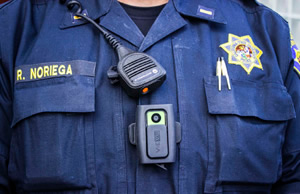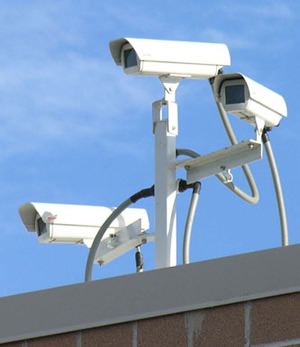Safety & Security (Prepare and Be Aware)
Security Technology On Campus
- By Michael Fickes
- 10/01/13

PHOTO © CODI MILLS / SPARTAN DAILY
Colleges and universities have never — or perhaps only rarely — dashed out to the leading edge of security technology. Given recent tragic events on campus, however, many are looking into newer security technologies such as biometrics, video analytics, handheld metal detectors, miniature video cameras pinned to lapels, near field communication (NFC) and other improved and emerging technologies.
Biometrics
“Biometrics is being used occasionally on campus,” says Steve Layne, a principal with Layne Consultants in Venice, FL, a consulting firm that advises colleges and universities about security. “Some schools are using fingerprint biometrics for access to residence halls. Our view is that biometrics security applications can be useful as long as you have a local company capable of servicing the technology. In many cases, competent service isn’t available.”
Biometric applications include fingerprint and handprint access control to physical doors and logical IT systems. Biometrics can also provide a second access step for doors requiring higher security. For instance, a laboratory with dangerous materials may require a card presentation and a fingerprint to ensure that the cardholder is the person named on the card.
Rick Thompson, a senior consultant with Lemont, IL-based RETA Security and an expert in college and university security, also notes that biometrics can complicate security unnecessarily. “You won’t see fingerprint biometrics used for charging food in the dining hall or for the laundry and vending machines,” he says. “But one-card systems can handle every application. I think one-card technology beats out biometrics.”
One-Card Security
One-card systems can serve as identification tools while providing access control for doors and computers. They can also provide a host of other services unrelated to security.
Debra Spitler, vice president, mobile access solutions with Irvine, CA-based HID Global, agrees and thinks that one-card technology is underused on campus. “Clearly there are many applications for one-card technology that many campuses aren’t using,” she says. “Some cities have set up systems to enable students to ride mass transit by presenting one-cards.
“Arizona State University makes housing assignments based on what students are studying, making it easy to form study groups. The student housing has systems that enable students to download study materials for their courses by swiping a one-card.”
Spitler suggests that brainstorming meetings among campus departments can lead to the development of additional one-card applications.
Video Analytics
 Video analytics systems installed in surveillance cameras can recognize certain patterns and send alerts to an alarm monitor. Patterns include a person running, a group converging on an individual, an abandoned package and others.
Video analytics systems installed in surveillance cameras can recognize certain patterns and send alerts to an alarm monitor. Patterns include a person running, a group converging on an individual, an abandoned package and others.
While a handful of campuses are making use of analytics, many public safety directors do not find analytics useful. One of the most commonly cited problems is the number of alarms the systems send out. Most, of course, are nuisance alarms, but all must be checked.
Some campus security directors prefer older, less expensive motion detection systems to video analytics.
Handheld Metal Detectors
“Handheld metal detectors are becoming common,” says Thompson. “They are much less expensive than a walk-through detector, and they don’t break down as often. I recommend developing clear policies for their use on individuals coming to events.”
It is also possible to provide ways for people to avoid being wanded, continues Thompson. The NFL, for instance, is now handing out clear plastic bags that allow visual inspection without wanding or searching through purses and carry bags.
“Where I see uses for handheld metal detectors at the university level is at special events,” adds Layne. “They are slower than walk-through scanners but effective when you have to pull someone aside.”
Smartphone Apps
One of the newer security technologies is an app that turns a smartphone into a panic button. Technically called “inbound emergency alerting,” these apps enable users to tap a button on the phone’s screen to dial the campus public safety office.
It is faster than a 911 call that must go through an emergency call routing center and be rerouted to public safety. Inbound emergency alert calls go directly to whatever phone number you program into the system.
 Alerts received by the public safety department include the name, phone number, email address and GPS location of the caller. The apps can be programmed to send emergency messages to public safety and help messages to friends or family — for cases that do not require help from the authorities.
Alerts received by the public safety department include the name, phone number, email address and GPS location of the caller. The apps can be programmed to send emergency messages to public safety and help messages to friends or family — for cases that do not require help from the authorities.
Also available are emergency guidance apps.
George Mason University (GMU) has rolled out a mobile emergency response app solution to students, faculty and staff. With more than 32,000 students, 800 acres and four separate campuses, GMU is leveraging In Case of Crisis’ mobile app (www.incaseofcrisis.com) to proactively prepare the Fairfax, VA-based university for specific emergency situations.
The solution allows GMU to publish their specific emergency procedures and instructions via an online portal to faculties’, students’ and staffs’ Apple and Android mobile devices. This information is then saved to the In Case of Crisis mobile app for immediate access even when data and cellular services are lost.
Complementing George Mason University’s traditional emergency preparedness efforts, including posters, flipbooks, guides and a website, the university-branded mobile app offers easy-to-use and secure mobile plans for emergency and business continuity scenarios, e.g., fire, earthquake, active shooter, etc., as well as appropriate responses, including steps to take, visual aids and key emergency contacts tailored to their multiple locations and audiences.
Wearable Video Cameras
“Wearable video cameras are a fantastic idea,” Layne says. “You pin them to your lapel, and they eliminate the problem of false accusations. We’ve also found that people don’t act out as much when an officer wears a camera. The video, of course, is very useful in court.”
“Wearable cameras are the future,” adds Thompson. “For years we have used tape recorders. Now we have audio and video recording.”
According to an article in the Spartan Daily, the student news portal of California’s San Jose State University (SJSU), university police officers are wearing miniature portable video cameras on their uniforms while they’re on campus.
Sgt. John Laws of the SJSU University Police Department, quoted in the article, says the cameras are to be worn throughout an officer’s shift, but won't always be turned on and recording footage.
“The department is recommending that the officers have it on any time they are actively contacting someone in a professional capacity,” he says.
Laws also said that it was up to the individual officer to decide when they will turn on or off the video camera.
“The video camera is fairly wide-angled, but it is not going to capture everything,” he says. However, if an officer catches “someone in the act of doing something,” they'll have it on video.
He said the video cameras aren’t just for reviewing footage, but also to record audio so officers can go back and listen to what someone is saying to them during an investigation.
GPS Tracking for Bicycles
According to the National Bike Registry, bicycle theft ranks as the number-one property theft crime on college campuses. To combat bicycle theft, some public safety departments have developed programs that educate students and staff about registering bicycles with public safety and using high-quality locks.
In addition, they placed bait bikes equipped with GPS trackers around campus.
Some of these trackers not only transmit the location of a stolen bike but also send turn-by-turn directions to the location.
At North Carolina State University, such a program used a $200 tracking device on bait bikes and reduced theft by 33 percent over an 18-month period.
Bulletproof Dry Erase Boards
The University of Maryland Eastern Shore recently bought a number of dry erase boards designed to function as bulletproof body armor if a shooting should break out.
The inventor, George Tunis, runs a company called Hardwire LLC that manufactures military armor. After the Sandy Hook shootings last year, Tunis told The Baltimore Sun that the teachers and administrators needed protection. “Those brave souls were trying to close the gap and get to the shooter and stop him, but they didn’t have anything that could stop the bullets along the way.”
Tunis designed the 18-inch by 20-inch boards to be used as shields.
Coming Attractions: Smartphones As Access Cards
An emerging technology called near field communication, or NFC, enables electronic devices to communicate wirelessly with each other over a very short distance — four centimeters or shorter.
What electronic devices will NFC-enabled smartphones communicate with? The two devices mentioned most often are credit card machines and access-control readers.
“We did an access control pilot with Arizona State University,” says HID’s Spitler. “The students loved it. While they can lose cards, they rarely lose their phones. They take them along everywhere.”
But NFC really isn’t here yet. Four things must happen before smartphone apps can become access-control cards and campus-one cards.
First, smartphones must be NFC-enabled. Samsung Galaxy III and IV have been enabled. Apple iPhones have not.
The electronic devices that smartphones will interact with — access-control readers, for instance — must be NFC enabled as well.
Third, a system for managing digital credentials and keys must develop.
Finally, network operators — Verizon, AT&T, Sprint and others — must develop systems for delivering mobile credentials to individual phones.
These four components aren’t here yet, but they represent the cutting edge of security technology today, and they are on the way.
This article originally appeared in the College Planning & Management October 2013 issue of Spaces4Learning.